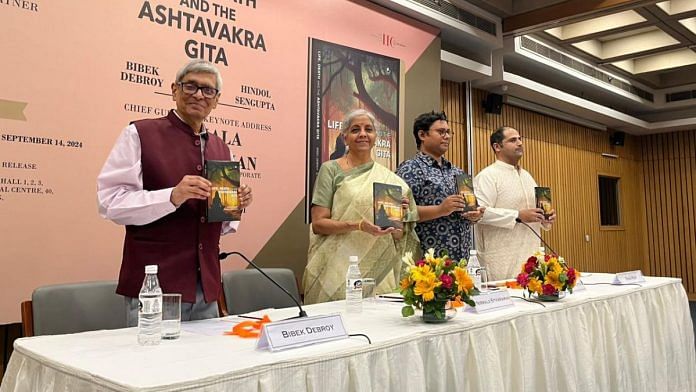New Delhi: Today’s kids are losing exposure to the richness of our heritage, a challenge that requires collective action to ensure future generations inherit this cultural wealth, said Union Finance Minister Nirmala Sitharaman at the launch of the book ‘Life, Death and Ashtavakra Gita’.
The event, held at the India International Centre, Delhi, saw discussion on the importance and impact of ancient texts, particularly those like the Ashtavakra Gita, and how the wisdom contained within these texts remains pertinent to contemporary time and contributes significantly to personal growth.
The book combines Bibek Debroy’s translation of the Ashtavakra Gita with the personal thoughts of Hindol Sengupta, who has shared his experiences and insights. It highlights the timeless teachings of Ashtavakra Gita and explores its relevance to contemporary life.
Praising the authors’ work, Sitharaman, who was the chief guest for the event, said, “What Bibek has done is remarkable. He is not just a translator; he has given a divine touch to our ancient wisdom”. She also reflected on the challenges of translating the Ashtavakra Gita, highlighting its complexity and the depth of understanding required for such a task.
The panel — Sitharaman, authors Debroy and Sengupta, and Rishi Suri, Co-founder, Grin Media — at the event also talked about the necessity of making India’s eternal stories accessible to contemporary audiences, ensuring that their deep insights resonate within the complexities of modern life.
Sitharaman highlighted how the Ashtavakra Gita imparts essential wisdom regarding life and death, stressing the significance of ‘gyaana’ (knowledge) and ‘vairagya’ (detachment). “Without gyaana, one cannot truly grasp the teachings of this text,” she said, identifying these concepts as fundamental to the discourse of the Gita.
Ashtavakra Gita is a dialogue between the king Janaka and the sage Ashtavakra.The text talks about oneself and raises questions like ‘who you are’, ‘what you are’, ‘what’s your purpose’, ‘why are you here’, and ‘where will you go next’. It deals with self-realisation and self enlightenment.
“In the ‘Ashtavakra Gita’, there is no fear in discussing death,” Sitharaman asserted, drawing parallels with other philosophical traditions within Hinduism.
Relevance in today’s time
The authors and the publisher seek to present this work in a manner that ensures that the profound insights of the ‘Ashtavakra Gita’ resonate with contemporary audiences, enriching their lives through the lens of ancient wisdom.
Hindol Sengupta underscored the importance of transforming “India’s eternal wisdom” into accessible narratives for contemporary audiences and readers. “We all have to live imperfect, messy, troubled lives. How does this wisdom matter at all?” he asked, stressing the need for relevance in spiritual teachings. His work on Ashtavakra Gita emerged from a personal crisis that forced him to seek deeper meanings amid the chaos of life.
“The Ashtavakra Gita provides us with a key, a code, a password, that can unlock the path that gives us a glimpse of true freedom,” Sengupta said. He compared the transformative power of spiritual knowledge to tasting honey for the first time, which awakens a sense of possibility beyond everyday existence.
The discussions took a personal turn when the authors shared their personal struggles, loss, and the quest to understand death through the Ashtavakra Gita.
Sengupta explained how the wisdom of this text helped him face the reality of his father’s illness, a pivotal moment in his journey toward adulthood. “Perhaps no child in India truly grows up until he has to face the death of a parent,” he said.
Debroy too shared his sentiment, saying that engaging with such texts creates a sense of detachment from worldliness and ambitions. This detachment allows one to navigate the turmoil of life with greater equanimity. “I wouldn’t say it has reduced my ambition or anything like that, but one definitely gains perspective,” he insisted.
Also read: British gave Delhi a makeover to show they weren’t all bad, ended up with Lutyens-Baker ego war
India’s literary treasures
The conversation moved toward the broader implications of reviving India’s vast literary treasures. Sitharaman also emphasised the wealth of knowledge embedded in regional languages and their texts and the necessity of rediscovering and disseminating these texts. “We have immense work available in regional languages that need to be republished,” she added, encouraging collaborative efforts to bring these stories to light.
Sitharaman also gave a reminder to everyone of the urgent need to preserve oral traditions that are rapidly fading generation by generation.
The event concluded with the speakers emphasising that by embracing this knowledge and translating it into our lived experiences, we not only honour our past but also illuminate paths to personal freedom and understanding in the present.
(Edited by Aamaan Alam Khan)






